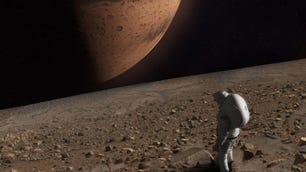Jupiter’s four largest moons are some of the solar system’s most compelling worlds. Io is dotted with active volcanoes, and Europa hides a subsurface ocean many want to check for alien life. Ganymede is the largest moon in the solar system, and Callisto is the system’s most heavily cratered object. Callisto is also home to an emerging mystery: The moon’s thick atmosphere holds a surprising amount of oxygen, and scientists aren’t sure why.
Observers have known about the presence of abundant molecular oxygen at Callisto for a while, with the working assumption being that the influence of Jupiter’s powerful magnetosphere could be knocking molecules of water, hydrogen and oxygen out from Callisto’s icy surface and into the atmosphere.
But when a team of researchers ran the numbers, they found that Jupiter’s magnetism can’t fully explain the amount of molecular oxygen around Callisto.
“There’s a huge discrepancy,” said Shane Carberry Mogan, lead author on a paper about the findings published late last month in the journal JGR Planets. “We were off by something like two orders of magnitude to even three orders of magnitude.”
For the layperson, that means there is 100 to 1,000 times as much molecular oxygen present in Callisto’s atmosphere as the scientists would expect to find if Jupiter’s magnetosphere stripping it out of the icy surface were the sole source.
The discovery of so much oxygen on an alien world may sound like a boon for the possibility that Callisto may support life, but the frozen world is probably far too cold for life as we know it. That said, plentiful oxygen could be useful in generations to come to explorers who may be able to use it for fuel and life support while traveling around deep space.
Here are other moons worth visiting in person





 +8 more See all photos
+8 more See all photos
It isn’t clear what’s happening at Callisto to produce so much oxygen, but Carberry Mogan hopes to get a better understanding of processes active in the moon’s surface that may yield an explanation or clues.
“That’s probably Callisto’s most enigmatic feature is its surface,” said Carberry Mogan, who’s a postdoctoral researcher in planetary science at the University of California at Berkeley. “It’s supposed to be an icy body, but when you look at it, it’s mostly this dark surface, anywhere from millimeters to kilometers deep.”
It’s still up for debate whether Callisto’s surface is more rock or ice. The dark material on its surface could also be ice-rich, providing a plentiful source for the mysterious amount of oxygen in the atmosphere.
For help with the mystery, Carberry Mogan is looking to upcoming robotic missions like ESA’s Juice and NASA’s Europa Clipper, which may swing close enough to Callisto to gather new data that could shed light on the puzzle.
“It’s really perplexing,” he said. “The next step is to figure out why there’s this gap between the source [of oxygen] and the observation.”
